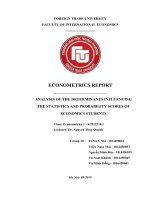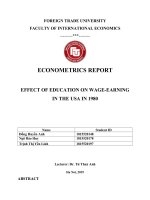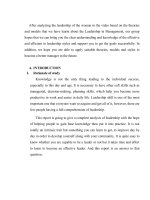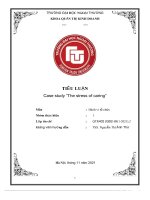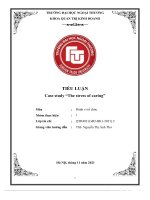(TIỂU LUẬN) topic enhancing the position of rail freight in short distance haul the cases of australia and vietnam
Bạn đang xem bản rút gọn của tài liệu. Xem và tải ngay bản đầy đủ của tài liệu tại đây (1.15 MB, 26 trang )
RMIT International University Vietnam
ASSIGNMENT COVER PAGE
Course Code
OMGT2279
Course Name
Transportation and Freight Logistics
Title of Assignment
Railway Comparison Business Report
Lecturer
Dr Nguyen Manh Hung
Student Name
Le Khoi Nguyen - s3682366
Tran Tram Anh - s3777334
Nguyen Hong Oanh - s3798758
Tran Thi Huong Mai - s3742777
Assignment due date
6 September 2020 (Week 10)
Word Count
Topic: Enhancing the position of rail freight in short-distance haul: The
cases of Australia and Vietnam.
Table of Contents
Executive Summary
3
I. Introduction
3
II. Background Information
3
1.Short-distance haul transportation in the railway.
3
2. Australia
3
1.1. Ownership
3
1.2. Network length
3
1.3. Freight task
3
2. Vietnam
4
III. Comparative analysis
5
1. Freight tonnage
5
1.1. Australia
5
1.2. Vietnam
7
2. Freight operations
8
2.1. Australia
8
2.2. Vietnam
10
3. Freight facilities
10
3.1. Australia
10
3.2. Vietnam
12
IV. Challenges
14
1. Australia
14
1.1. Congestion in the Port and Terminal system:
14
1.2. Limited Freight Services and Operations for Short-Haul Demand:
15
1.3. Out-of-date facilities
16
2. Vietnam
V. Recommendations
16
18
1. Australia
18
2. Vietnam
19
VI. Conclusion
20
VII. References
21
VIII. Appendices
25
Executive Summary
I. Introduction
II. Background Information
1.Short-distance haul transportation in the railway.
According to Marinov et al.(2011), short-distance haul transportation in railway is basically goods
transported in a short distance, giving more access to individuals and small enterprises with lessthan-truckload packages in railway. The short-distance transportation is dominated by road freight,
since it costs less than railways in the few first miles, and also more convenient to deliver door-todoor.
However, railways have potential to compete with the road sector if they want to expand their
economies of scale and sustain in the long run. Firstly, as the E-commerce and Logistics industry
are rising significantly, there is a growing demand for individual’s small packages to be delivered,
thus extending the market and opportunities for the railway sector. Standing from the railway's
owner’s point of view, they can utilize more assets and save time as well as cost when delivering
goods as piles of different orders. Applying this also helps boost the domestic GDP because more
trades will be executed within the country. Moreover, trains consume less fuel than trucks and cars
so it is better for the environment as well.
2.Requirements for Short-Haul Freight:
In order to compete with road transport in terms of short-haul freight, the Railway system\needs to
fulfill some conditions to fit with the requirements of short-haul freight services in terms of response
time, service times, cost effectiveness, profitability for owners, operators and users(Marinov et al
2011).
.
First, the short-haul non-bulk freight requires the next-day delivery or express delivery (within 2-5
working days). Therefore, delay and congestion in the delivery process should be minimized in Rail
freight services (BITRE, n.d). For another requirement, the rail freight service must be economically
viable to adopt the wide range of traffic and commodity flows as a part of wider freight services
offering to different types of business (Marinov et al 2011). Hence, the wider service range could
attract more customers and reduce the cost and risk burden as a whole since it could be shared by
multiple firms for the same short-distance freight. The next standard for short-haul service is the
sufficient number of terminals and pick-up points that have enough proximity to the final destination
of customers. For short-haul, the proximity location is compulsory for transshipment operation,
which would require additional transportation to be involved in the final delivery or pick up process
(Marinov et al 2011). Lastly, rail must be able to deliver the economies of scale in terms of rail
freight rolling stock and operation, which means that significant changes in the freight vehicle
configuration, size, loading and discharge options including bulk and palletized traffic and
also need to be made for the purpose of reducing traction costs.
3. Australia
3.1. Ownership
Rail freight transport used to be monopolized by Australian state governments. However, ever
since the successful deregulation, commercialisation and privatisation commencing from the 1980s
(Everett 2006), the industry has become a fiercely competitive playground for several operators,
either operating in regional (Genesee & Wyoming Australia) or national (Aurizon and Asciano)
scales. Logistics and mining businesses also operate and train on their own railways (National
Transport Commission (NTC) 2016).
3.2. Network length
According to the 2019 report compiled by Bureau of Infrastructure,Transport and Regional
Economics (BITRE) and Australasian Railway Association (ARA), Australia currently possesses
approximately 32,900 and 314 route-kilometres of operational heavy railways and light tramways
respectively. With just two main functions: passenger and freight transport, the system contributes
over $26 billion to the national economy (Austrade n.d.).
3.3. Freight task
The role of rail in Australia’s economy is prominent, especially to bulk export commodities. Over
50% of the nation’s freight task is attributed to railroads (see Figure 1 for proportions and Appendix
1 for raw statistics), outstandingly transcending other means of transportation, especially air
shipping (ARA 2019).
Figure 1. Adapted from: BITRE 2019
Australian freight task, by mode, 2015-16
The two largest bulk flows reported on Australian railways are exporting iron ore and coal. Some of
the other goods also hauled by the railways to ports include bulk grain (cereal grains, pulses,
oilseeds), bulk sugar canes and other non-bulk freight (BITRE 2019).
In general, rail transport already has an unrivalled competitiveness in long-distance bulk freight
haulage in Australia.
4. Vietnam
The railways in Vietnam are run by a state-owned corporation as Vietnam Railway Corporation
(VNR), which has two major subsidiaries namely Hanoi Railway Hanoi Railway Transport Joint
Stock Company and Saigon Railway Transport Joint Stock Company. Being placed in a monopoly
position limits the freedom and competitiveness of the market, leading to less investment and
interest in the industry from outside stakeholders. Although it can be understood that railway is an
important means of transport that gives access to entering the country, the government needs to
pay more attention to this potential business opportunity.
The reason why it is deemed potential is because it is built across the country and runs through
half of the provinces and cities of the nation, which enables a majority of the population to reach
this mode. The total length is 2600 kilometres, with 11 lines, in which the North - South railway
which was built during the French colonial period to transport goods from the North to the South
now allows the same function but is used by Vietnamese. Moreover, it also interlinks with China,
Cambodia and Laos, making it easier and cheaper to export. Even with short-distance haul, it is
still a very profitable and promising medium compared to the road transport that is used dominantly
in Vietnam.
-
III. Comparative analysis
1. Freight tonnage
Tonnage transported in Australia completely outweighed that in Vietnam in the collected data.
Despite being recorded in different years, there were no special events in between to create an
adverse effect, so Vietnam needs to work harder on railway freight transportation in terms of goods
volume.
1.1. Australia
As estimated by ARA (2017), the freight tonnage moved on rail in Australia is approximately 1.5
billion tonnes each year. Due to the unavailability of data, the latest rail freight task recorded was in
2015-16 by BITRE and ARA which totalled to about 1.4 billion (see Figure [..]). This was a gigantic
thousandfold leap compared to around 663 thousand net tonnes just 9 years before that.
Figure [..]. Reproduced from: ARA 2019.
National rail freight task, thousand net tonnes.
The catalysts behind such growth was almost entirely the simultaneous growth in iron ore and
despite to a lesser extent, coal exports as well. In 2015-16, the former accounted for around 65%
of the total rail tonne kilometres, while the latter’s share was 22% (see Figure [..] for raw statistics).
Only a marginal share belonged to other bulk and non-bulk rail freights. However, since both also
experienced 26% and 6% growth respectively in 2015-16, they further justified the increase in rail
freight tonnage.
Figure 2. Reproduced from: BITRE 2019
Australian rail freight task, by major commodity group, 1971–2016
Such enormous climb in rail freight tonnage as aforementioned is a vivid proof of the phenomenal
development of Australia’s rail transport system which is predicted to advance even further
(between 13% to 35%) in the years to come (BITRE 2019).
1.2. Vietnam
Figure: volume of freight carried in thousand tons of railway freight transport from 2017 - 2019
(adapted from General Statistics Office of Vietnam n.d).
The maximum weight per standard wagon is 60 tons, and the 1 metre gauge line is from 25 to 40
tons (Banomyong, Thai &Yuen 2015)
Thousands of goods are carried annually by trains in Vietnam. In the first quarter of 2020, it was
reported that there was 10% - 11% of growth in freight revenue compared to the same period last
year (Duy 2020). VR have collaborated with chemical corporations in Vietnam in order to reach the
goal of 1.6 million tons in rail freight in 2020, delivering products such as apatite, fertilizer,
chemicals, etc… Besides, VR also plans to direct their business strategy from passenger to freight
transportation and together with the Agriculture Ministry, directly exporting fruits and frozen
agricultural products to China.
To vary the sorts of goods delivered, VR intends to run more freight to make it up to the loss of
passenger one under the Covid-19 pandemic situation, which opens a new gate for the shortdistance haul of railway to further develop.
2. Freight operations
2.1. Australia
Regarding regions with high rail freight tasks, currently, the Pilbara region in the Western
Australia occupies the biggest bulk haulage task, transporting 94% of the country’s iron ore exports
(ARA 2019) and representing around 70% of Australia’s total freight task. With a complex and
highly integrated network, the East Turner River valley in the Pilbara has the third-busiest rail
corridor in the globe and is expected to become the busiest soon (BITRE 2019). Queensland and
New South Wales also have quite sizeable bulk flows (19% and 6% of the total rail freight task in
order), mostly coal movements because these cities are home to Australia’s coal extraction (ARA
2019).
As briefly mentioned above, the major type of freight that Australia’s railway network transport is
bulk commodities, with the entirely intrastate rail traffic. It remains the dominant and the most
efficient means of transportation to move bulk iron ore and coal from inland mining sites to ports all
over Australia for exports, allowing Port Hedland to be the globe’s largest bulk export port and
securing Australia’s position as the top iron ore exporter in the entire world. As for agricultural
products like grains and oats, they are normally transported over long distances in which rail has
traditionally been the predominant mode as well (BITRE 2019).
With regard to rail freight fares, over the last few decades, the rate has been continuously
declining from a high of around 11 cents/net tonne kilometre to only 4 cents in 2019 (see Figure [..]
for this trend). The BITRE (2017) has forecasted that this rail fares will level off at 4 cents/net tonne
kilometre until 2030.
Figure [..]. Reproduced from: BITRE 2017.
Real rail freight rates and prediction
Finally, in terms of rail freight utilization, it is difficult to identify a standard capacity metric for the
national rail network due to the variety of commodities and the differences in capacity of each track.
Nevertheless, it can still be inferred that up to now, Australia’s rail freight transport has been rather
efficient. So far, no evidence of capacity constraints on interstate routes has been reported. In other
words, every customer seeking access to the rail freight system is satisfactorily served. Whenever
they approach a track manager, a preferred time of access will be stated for them to know when
they can use the railways to transport goods (NTC 2016). This explains the dominance of rail in
Australia’ freight transport activities.
2.2. Vietnam
Like Australia, railway is often used for bulk commodities but the goods are more variable, from
groceries, medicines to hard metal, coal. The rail freight fares are usually higher than sea freight
but lower than air and equal to road type, placing them in the middle of the market. However,
assets are not fully utilized because of the poor infrastructure and outdated facilities.
Despite providing online booking through phones, the consignor can not track where their
packages are going, also have to deal with protracted and unscheduled freight that leads to
frustration and less users.
Management has been proved to be inefficient and even corrupted after some allegations
involving the bribery of a Japanese company to several officers of the railway management
board (Xinhua News Agency 2014). Even though the government shows interest in
investing in and leveraging the position of railway freight transportation, few signs of
practical actions have been shown.
Because of ineffective and neglected management, revenue is not well-generated, hence affects
investment from the government funding and also outside investors. It is difficult to develop in the
long term if this situation remains unchanged, so the owners need to seek for alternatives to
improve the issue.
3. Freight facilities
3.1. Australia
As stipulated by Austrade (2013), the globe’s longest and heaviest haul trains are from Australia,
with each one at least 2.5 km long. The axle loads are 40 tonnes, which means each freight train
can carry up to 110 trucks worth of freight off the road (ARA n.d.). Among the 32,894 routekilometres of operational heavy railways, about 10 percent are electrified. Apart from these,
Australia is also utilizing around 2005 locomotives, half of which has stayed in use for 12 years or
less. Due to such an old age, Australia has been limiting the use of this kind of train and leveraging
locomotives for freight duties merely (ARA 2019). With the majority of railways being heavy types,
Australia’ rail transport is mainly utilized for long-distance freight hauls.
As regards connectivity, the exceptional rail facilities has allowed Australia’s rail network to connect
with multiple ports scattered over the nation. It serves as the primary mode of transport in three
freight movements as below:
(1) From inland terminals to ports on railroads - this traffic encompasses either mineral or
agricultural products that Australia exports. All of the nation’s principal ports, including
Port Hedland, Dampier, Port Walcott and Esperance, for example, receive their iron ore
exports through railways. That tonnage reached up to 677.8 million tonnes in 2017-18,
which also equated to these ports’ total tonnage exported (ARA 2019).
(2) From port terminals to urban logistics centres - this mostly applies to Australian imports.
Consignments are shifted out of ports to logistics centers by rail transport in short-haul
trips to be distributed to local businesses. Empty containers are evacuated out of port
to avert congestion by trains as well (ARA 2019).
(3) From one port to another - One classical example of this route is container movements
from the Port of Hobart to the Port of Burnie for exports or simply for mainland transfers
among different ports (ARA 2019)
These three routes prove that Australia has impressive connectivity between ports and rail
transport. The nation shows non-stop attempts in creating more regional freight links, with an
investment worth $9.3 billion in a special program called Inland Rail to further connect different
markets in Melbourne, Brisbane and Victoria together for even larger economic benefits
(Department of Infrastructure, Regional Development and Cities n.d.).
With respect to the accessibility of the railway line, Australian’s rail networks mainly radiate from
the state capitals, then spread out to other states with highly integrated cross-border links (ARA
2019). The country’s rail freight dominates Melbourne - Adelaide - Perth - the east-west corridor. In
the north-south corridor (Melbourne - Sydney - Brisbane), its competitiveness is not that lucid due
to infrastructure constraints. However, overall, rail network still provides integral corridor links
between capital cities in Western Australia, South Australia, Queensland, New South Wales and
Victoria (NTC 2016).
Regarding rail containers, and Adelaide, Australian trains can already carry double-stacked
containers whose total height must not surpass 6.5 metres above the top of the rail, specifically in
Darwin, NSW, Perth, Parkes. Furthermore, road freight vehicles can also be piggybacked on rail
flat wagons in the central corridor line (ARA 2019). These methods of freight transport can be very
efficient in improving capability.
3.2. Vietnam
Vietnam uses tracks, bridges, tunnels, signalings, communication and sewers facilities to
operate the railway freight transport system.
With respect to accessibility, according to the map of Vietnam’s railway below, the
railroad is built across the country from North to South, with the purpose of connecting the
North and South of Vietnam. Hence, it is very convenient for both long and short distance
haul freight and has great potential for future development in the logistics sector as it
connects the whole country and involves very little intermodal transport.
However, compared to the general quality indicators, on a scale from 0 to 7, Vietnam’s
railway infrastructure only ranked at around 2.5, while the regional average positioned at
about 4 in a report written in 2012 (WEF 2012). The railway has been operating for so long
but showing little revenue in return, which shows a significant imbalance in railway
operation. While locomotives are supposed to be used for less than 30 years, 89 of them
are 30 - 40, 45 are more than 40 years. Infrastructure, rolling stock, signalling and telecom
systems are main concerns when operating the railway, yet is underdeveloped or outdated
because it only has government’s funding as the main source. This directly affects the
overall performance of the means of transportation in terms of short-distance haul freight.
Moreover, very few warehouses and unloading yards storage makes it harder for shortdistance transportation to be executed. VR is making an attempt to expand this factor in
the upcoming years to make way for short-distance haul transportation (Duy 2020).
IV. Challenges
1. Australia
1.1.Inappropriate Service offering, infrastructure and Logistics performance for Short-haul
freight:
For the Australia railway system, one of the main challenges that constrain the growth of freight
railway service is the delay of freight operations due to the track congestion in Sydney Port access.
As a result, a freight could have to wait up to 14 days for another ship to arrive at the port (Figure).
This disadvantage of the railway system has indirectly boosted road transport for short-haul freight
tasks between Sydney and Melbourne since there are new road reforms and new road
infrastructure, making it more time-efficient for short-haul transport to use road freight instead of rail
freight (ARA, 2019).
Ports
Terminal
Waiting
time(Days)
Newcastle
Hayden Terminal
10-14
Newcastle
Dyke Terminal
8-12
Hay Point
Dalrymple Bay
7-14
Hay Point
Hay
Point
Coal
1-5
Terminal
GladStone
GladStone
1-4
Figure : Waiting time in bulk port terminal for clearance (Reproduced Bertho 2010)
Part of the reason for the congestion in the port and terminal system came from the network
constraint such as linne tonne axle load and the insufficient requirements of vertical clearance that
limits the size of the reference train (PWC, 2017). Furthermore, the insufficient road length and
material handling equipment increase the spent time for the load and unloading operations of rail
freight (PWC,2017). As the Figure 1 shown, most of the rail network of Australia are narrow and
standard gauges except only the network in Victoria and New South Wales, where it has the high
traffic intensity. With the requirement of short-haul freight, which requires no delays and
congestions. Therefore, with the shift from road freight to rail freight, the broad gauge of the rail
network is inevitable.
Figure 1: Australia rail network.
Keeping up with the fast growth of the transport task is another main priority of the railway freight
industry in order to satisfy the demand shift from road freight. With over 50% contribution of freight
tasks made by rail mode (figure 2), it is estimated that the freight task growth will be 26% by 2026
(Deloitte, 2017). The deregulation, privatization, and commercialization of the railway industry have
largely contributed to the expansion of the rail fleet with 2005 locomotives (ARA, 2019). Hence,
there is room for investment in rail freight. However, the transport services of the players in the
industry are mainly industrial and agricultural - oriented (Table 1), which is going opposite to the
trend in the age of consumerism. When people prefer online shopping rather than physical
stores.Therefore, it is anticipated that the demand for short-haul freight will increase. For instance,
railway accounts for the majority of inter-capital origin–destination non-bulk freight on the East–
West corridors (NTC, 2016). Additionally, inner-capital non-bulk freight occupies 30% of rail freight
market share and it is expected to go up even more in time. The current infrastructure for interstate
rail freight in big cities is limited since there are many integrations of freight and passenger services
in one rail line, including Sydney interstate and Perth interstate rail lines(Coleman et al
2017).Therefore, the adjustment in service functions of railway operators in the market is
compulsory for the adaption to the non-bulk freight demand for transport tasks.
The current circumstances of COVID-19 have created an enormous impact on the price of fuel ,
creating the declines in the fuel prices (IBIS, 2019). Subsequently, the declines in prices would
increase the competitive advantages for road freight over rail freight since rail freight is more fuelefficient than road freight. Therefore, only the increase in fuel price can benefit the rail freight
industry while the decrease in fuel price would increase road freight usage since the fuel cost gap
between the two freight options is narrowed.
For another challenge, most of the railway network in Australian is single-tracked railways
(approximately 89%) with the only few exceptions like the Melbourne-Sydney line (NTC,2016).
Single-tracked lines, which share both directions of the railway on the same truck, will limit the
infrastructure capacity of the railway system and lead to the shortage of trains when the level of
short-haul demand spikes up. Furthermore, the single tracked railways mostly consist of narrow
and standard gauges. Hence, with the tremendous traffic frequency of short haul freight, one train
delay will lead to propagation of delay thus slowing the short haul operation as a whole.
In terms of commodity-based rail freight network, the current rail freight facilities for industrial
commodities like coal, iron ore and steel has provided sufficient options with heavy haulage rail
lines and direct access to trading ports and export ports (NTC, 2016). However, it’s not the same
case with Short-haul commodities, the lack of urban terminals with fragmented land-use for freight
services are big issues in the fundamental facilities for short-distance freight. In Particular, Many
terminals and pick-up and delivery (PUD) are inefficiently configured and poorly located relative to
current major freight generators (Coleman et al 2017). Simultaneously, the increasing problem of
urban congestion is causing significant inflation in the cost for pick-up and delivery. As a result, the
decline in efficiency of last mile tasks is caused by these facilities constraints of the Australia
railway system.
2. Vietnam
The railway services are not efficient and flexible enough to effectively support short-distance haul.
First, there are very few train schedule available, attributing to the downgrading infrastructure that
causes much longer delivery time. Specifically, there is up to 85% of national railway is single 1
meter track. Most of the 297 terminals in Vietnam are small and in dire need of renovation and the
locomotives and wagons are obsolete (produced 30 years ago) (Vietnamnews 2019). Normally, a
Rail-shipment would take 2 days, not to mention the 3 days taken to schedule for a shipment
(ANTD 2014). There is also a case that oversized shipments have to be transferred from Rail to
Road twice (rather than being shipped by Rail only) and travel on longer route since there are
height restrictions at some tunnels (Beresford, Pettit & Wang 2014). Second, several terminals
have small capability of warehousing and loading yards (Duy 2020), which cannot serve large
quantity of shipments, indicating that the short haul seems to be unviable currently.
Operation inefficiency, along with the lack of investment, has led to Rail not being as competitive as
other transport modes. While there is 90% of annual investment from the State in Roads, this
amount for Railways is only 8%, just enough for general maintenance rather than significant
upgrades (ADB 2017). The Railway’s market share, hence, inevitably declined to only 1% (UIC
2017), giving place to other transport modes, particularly Road, Air and Maritime (Figure). This also
results in private firms’ investment preference towards other modes than Railways. The situation of
Rail-Road investment imbalance hence hinders the effectiveness of Rail-intermodal and its
importance in helping reduce road and port congestion and domestic short-haul. For instance,
inefficient delivery time and low shipment productivity cause disconnection between Rail and Sea
transport. Specifically, the Hanoi - Haiphong - Quang Ninh route only links with three sea ports (i.e.
Cai Lan, Vat Cach, Hoang Dieu), while some branch lines linking other ports have been
demolished (Vinalines 2019).
Besides, with the railway inefficiency and low capability, despite the lower freight tariff (VND
40,000/ton/km (ANTD 2014)), it is understandable why firms/customers in need of transporting
products would prefer other transport modes, particularly road, as they can be more flexible in
schedule shipments with trucking companies.
Figure. Freight traffic in Vietnam from 2010 to 2018, by type of transport (Reproduced from Statista
n.d.)
V. Recommendations
1. Australia
1.1.Optimizing Operational network and infrastructure for short-distance haul.
In order to reduce the congestion and slow speed of transport of the rail freight service, the broad
gauge railway must be fully implemented into the rail network. Given that rail freight demand for the
followings years will be up by 26% while the current standard gauge railway only allows 21 tonne
axle loads at 110 and 115 km/h, which limits the speed and quantity of goods and speed thus
decreasing time-efficiency of rail freight and e-commerce delivery in terms of speed as discussed in
the previous parts (Coleman et al. 2017). Along with the broad gauge, the wagon size and train
length, which is limited by the loop lengths at up-country silos and/or receival roads at export port
terminals, also need to be adjusted. Hence, it is highly recommended to put more loops at these
export ports and terminals to aid traffic flow and enable additional trains access (Wong & Rosser
1978). Simultaneously with the implementation of broad gauge railway and additional loops, the
tonne axle should be increased in order to enhance the competitive advantage of rail freight,
exploiting the economies of scales in short-distance delivery (Coleman et al. 2017).
For the purpose of shifting freight from road to rail, the fundamental facilities and services for shorthaul corridors, which is dominated by road freight, must be established.The cross-metro shuttles
for rail freight, which is a method that has been successful in Sydney, needs to be replicated in
multiple regions throughout the countries due to its multi-user terminals function and co-location
services. These advantages of the cross-metro shuttles would erase the need to break trains up
and shunt between stevedores, which adds the handling cost and loading/unloading time to the rail
freight operation in general and intermodal operation in specific (PWC 2017).
The booming of interstate road freight with two-way freight service throughout the country is one of
the reasons that explains the dominance of road freight in short-distance haul (NTC 2016).
Since most of the railway lines in Australia rail network is single-tracked line. Which is not an
appropriate type of railway for two-way freight. Therefore, double-tracked lines are compulsory for
Australian railway network to achieve an efficient two-way loading freight profile with disparate
products and freight categories. Which is one of the services that complement the e-commerce
logistics industry. Subsequently, stimulating the demand for freight in short-distance haul in the
near future.
2. Vietnam
2.1. Key Infrastructure Improvement
To fulfill the requirements of short-distance haul, Vietnam’s Railway primarily needs a
reconstruction on key infrastructure, acting as a solution in the near future. Tracks, stations,
signaling and telecom systems shall be renovated to increase overall operation effectiveness
(Vietnamnews 2019). Specifically, the convention 1-meter gauge could be replaced with current
global standard one (1.453 meters wide (RailSystem n.d.)) to speed up delivery. Then, the other
key facilities - locomotives and wagons - could be replaced correspondingly with newer model.
Furthermore, the new warehousing area and loading yards could be expanded in more terminals
throughout the North-South railway.
By improving efficiency (faster train) and capability (carrying larger shipments), these key
infrastructure upgrades would also support intermodal options with rail for short-distance shipping.
Specifically, there will be a connection between railways and logistics center near ports (e.g.
Haiphong’s industrial zones). In fact, a petition regarding the rail-track width reconstruction for Lao
Cai - Hanoi - Haiphong and Lang Son - Hanoi - Haiphong routes has been proposed to promote
such intermodal option (PTSC 2017). Furthermore, with the expansion of warehousing area, short
haul can be more easily executed at terminals throughout Vietnam, promoting the connection
between rail and trucks (i.e. rail-road intermodal option).
Such crucial improvements would highlight the national railway’s potential for development and
attract private enterprises’ participation. Meanwhile, the pressure from external investment would
make VNR eliminate the monopoly mindset and hence attempt to be more competitive.
2.
Further Infrastructure Improvement
In the long run, with the support from Government and private enterprises, the Railway could aim
at offering higher-quality standard for short-distance shipments. First, VNR could equip techniques
at warehousing areas to support shipments transferred from different modes and serve wider range
of products. Specifically, some basic techniques for (un)loading services such as forklifts and
trucking facilities should be provided so that customers do not have to outsource such services.
Moreover, with the existing temper-modified containers and wagons, temperature-control
techniques and a special area should be designed for temperature-sensitive products (e.g. fruits,
meat).
With the short and long-term infrastructure improvements, the railway can be more competitive as
other transport modes and potentially shift customers to use railway, given the aforementioned
promising merits.
Second, the railways could be equipped with tracking technology to support visibility. Specifically,
currently Trimble is developing a technology for real-time tracking and inspection on tracks and
wheels using image optical and 3D scanning (Trimble n.d.), called TreadView. If installed,
TreadView can help to detect abnormalities for in time maintenance. By this way, the operational
cost could also be reduced as currently VNR is using large number of manual workers to inspect
tracks daily (Ha 2019).
Figure. TreadView Technology (Reproduced from Trimble n.d.)
VI. Conclusion
This paper gave insights into the railway systems of Australia and Vietnam via a comparative
research approach. It can be seen that Australia’s railway system is more advanced than Vietnam’s
as regards three dimensions - freight tonnage, operations and facilities, indicating a higher usage
of railways for freight transportation in Australia. Nevertheless, both countries still face challenges
in executing freight short-distance haul. Recommendations are given for both nations to improve
short haul performance. Australian railway needs to be upgraded regarding its fundamental
infrastructure to reduce congestion and satisfy the rising demand for non-bulk shipments, while
Vietnam’s key infrastructure should necessarily be reconstructed and then head to the equipment
of more advanced facilities. By this way, hopefully both countries would achieve competitive
advantages in developing short-distance shipment via railways.
VII. References
Austrade n.d., ‘Australian industry capabilities - Rail’, Austrade, viewed 24 August 2020,
< />Austrade 2013, Heavy haul, Intermodal and Freight rail, Austrade, viewed 24 August 2020.
Australasian Railway Association (ARA) 2017, A National Rail Industry Plan for the benefit of
Australia, ARA, viewed 24 August 2020, < />ARA n.d., Rail freight and Ports Executive Committee 2020 - 2022 Strategic Plan , ARA, viewed 24
August 2020, < />Department of Infrastructure, Regional Development and Cities n.d., Delivering on freight,
Department of Infrastructure, Regional Development and Cities, viewed 24 August 2020,
< />Bureau of Infrastructure, Transport and Regional Economics (BITRE) 2019, Australian aggregate
freight forecasts – 2019 update – Research Report 152, BITRE, viewed 24 August 2020,
< />BITRE
2017,
Freight
Rates
in
Australia,
BITRE,
viewed
24
August
2020,
< />Vietnamnews 2019, ‘The State needs do more to attract private investment in railway
infrastructure’, Vietnamnews, viewed 23 August 2020, < />Quan, D 2018, ‘The apparatus is cumbersome, overlapping’, Tuoi Tre, viewed 23 August 2020,
< >.
Minh, A 2017, Vietnam Railways in grave need of restructuring, Vietnam Investment Review,
viewed 23 August 2020, < />ADB (Asian Development Bank) 2017, Viet Nam: Improving Public Expenditure Quality Program REFORMING RAILWAY AND METRO ASSET MANAGEMENT, ADB, viewed 23 August 2020,
< />Phuong, A 2020, ‘Restructuring Vietnam Railway Corporation’, VOV News, viewed 23 August 2020,
< >.
UIC 2017, Vietnam Railways: Challenges, Opportunities and Development, UIC Communications,
viewed
23 August
2020,
< />
opportunities-and-development?page=iframe_enews#:~:text=Vietnam%20Railways%3A
%20Challenges%2C%20Opportunities%20and%20Development,-Asia%20Pacific&text=The
%20quality%20of%20infrastructure%2C%20rolling,30%25%20of%20the%20total%20demand.>.
ANTD 2014, ‘Đường Sắt Việt Nam đói trên đống vàng’, An Ninh Thu Do, viewed 23 August 2020,
< />Everett, S 2006, ‘Deregulation and reform of rail in Australia: Some emerging constraints’,
Transport Policy, vol. 13, no. 1, pp. 74-84.
Trimble n.d., TreadView - Wayside Wheel Tread & Surface Inspection System, Trimble, viewed 23
August 2020, < />Cruz, CO & Sarmento, JM 2017, 'Horizontal bundling of infrastructure managers: The case of
Portugal Infrastructure Company (roads and railways)', Transport Policy, vol. 55, pp. 99-103.
Rodrigue, J-P et al. (2020), Railway Deregulation in the United States, The Geography of Transport
Systems, Hofstra University, Department of Global Studies & Geography, viewed 23 August 2020,
< />Ha, M 2019, Đâu rồi 'con tàu Việt Nam đi khắp bốn mùa vui'?, Thanh Nien, viewed 25 August
2020,
< />
1140254.html>.
RailSystem n.d., Rail Gauge, RailSystem, viewed 24 August 2020, < />Statista n.d., Freight traffic in Vietnam from 2010 to 2018, Statista, viewed 24 August 2020,
< />Vinalines 2019, VÌ SAO LOGISTICS ĐƯỜNG SẮT YẾU KÉM, THIẾU KẾT NỐI VỚI CẢNG BIỂN? ,
Vinalines, viewed 24 August 2020, < />Bertho ,F,
/>
ARA, 2019, />
Deloitte, 2017,
/> /> /> /> />
ARA,2019
/>IBIS, 2019,
/>BITRE, n.d, ‘Road and Rail freight: Competitors or Complements, Report, Viewed 1th
September 2020,
/>PWC, 2017,
/>_Terminals.pdf
NSW, 2018
/>%20and%20Ports%20Plan%202018-2023_0.pdf
/>a5ecfffc09123a59f1478eec8bc4e35071b/363257/Woodburn_2003_final.pdf
Coleman, P, Harris, D, Ronan, S, & Hammersley, P, 2017,
/>
Wong, O., & Rosser, M. (1978). Improving system performance for a single line railway with passing
loops. New Zealand Operational Research, 6(2), 137-155.
/>
Dolman, G, 2016, Australian logistic council dialogue, 21 April, Viewed 28 August 2020,
< />Koziarz, J, 2017, Transportation that built Chicago: The importance of the railroads, 21 Sep,
viewed 28 August 2020, />Bertho, F. (2010). Maritime transport in Australia. The Impacts and Benefits of Structural.
/>Marinov, M., Mortimer, P., Zunder, T., & Islam, D. 2011, Short haul rail freight services. RELIT-Revista de
Literatura dos Transportes < />
4E47-90CC-BD591A1CE078.pdf>
/>
/>
VIII. Appendices
1. Table
Table 1. Overview of the operators in the rail industry.
Chart

